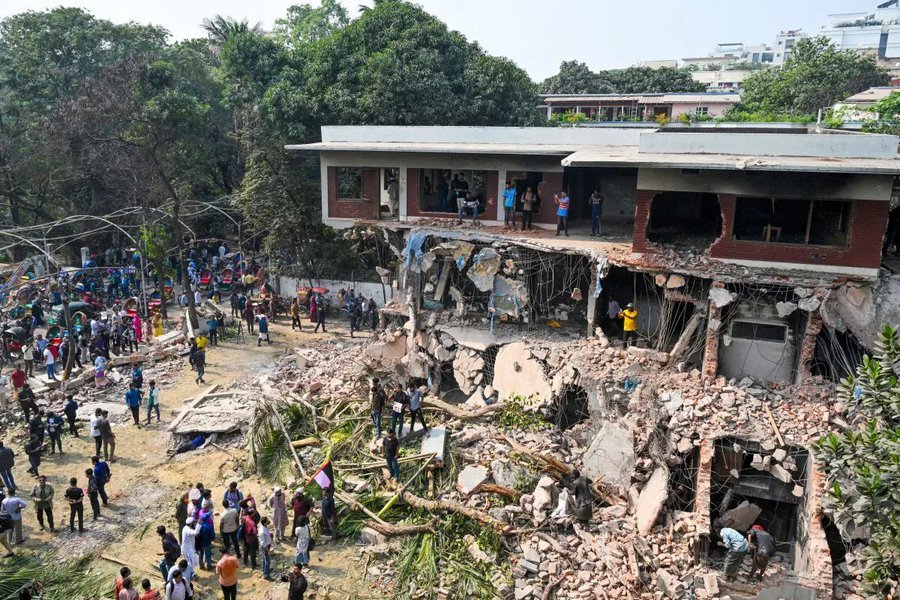On Thursday, Bangladesh was rocked by a wave of violent protests as hundreds of demonstrators took to the streets to destroy buildings linked to the ousted former leader Sheikh Hasina and her family. The protesters, armed with hammers, metal rods, and even government-owned excavators, targeted significant landmarks tied to the legacy of the former prime minister, including the museum and former residence of Hasina’s late father, Sheikh Mujibur Rahman, the founding father of Bangladesh. This act of destruction marks the latest chapter in the country’s ongoing political instability, which has been exacerbated by dissatisfaction with Hasina’s 15-year autocratic rule and the manner in which she was ousted from power.
The wave of protests started after reports surfaced that Hasina, who fled to India last year following the student-led revolution, was planning to appear publicly through a Facebook broadcast from exile. Hasina, now 77, is wanted in Bangladesh for her involvement in massacres during her time in office, and the idea of her returning to the spotlight triggered widespread anger and frustration. In the capital Dhaka, protesters gathered in front of the museum dedicated to Hasina’s father, which had already been set on fire in the aftermath of the revolution. The protesters, in a show of defiance, began to tear down the remaining walls of the building using excavators. This act of destruction was not confined to Dhaka alone—other cities, including Khulna, Kushtia, and Chittagong, witnessed similar scenes of violence as demonstrators vandalized and torched properties linked to Hasina’s family.
The violence escalated in the early hours of Thursday morning when protesters stormed Hasina’s former home in Dhaka, beating down the walls with tools and setting fire to the property. The protesters were also seen attacking other buildings tied to her legacy, including the house of her late husband in the capital. In Khulna, the home of Hasina’s family was demolished using government machinery, further highlighting the scale of the unrest. In Kushtia, a prominent leader of Hasina’s Awami League party, Mahbubul Alam Hanif, had his house vandalized, while in Chittagong, protesters burned effigies and destroyed a mural of Sheikh Mujibur Rahman.
Despite the growing violence, the interim government in Bangladesh has remained largely silent on the unfolding crisis. Security forces were reportedly standing by as the destruction took place, unable or unwilling to intervene. In some neighborhoods, citizens expressed their fear and frustration, with one private security guard sharing his concern over the spread of flames to nearby homes, which housed families. “We cut off the electricity line ourselves,” said Jamal Uddin, a guard in the area. “I don’t know when the situation will return to normal.” The protest, which was originally sparked by a desire for justice, has escalated into a full-scale revolt that continues to disrupt daily life across the country.
The violence and destruction are a clear sign of the deep political rift in Bangladesh. For many, the protests are an expression of their frustration with Hasina’s authoritarian rule, and her inability to face justice for alleged crimes committed during her time in office. For others, it represents a call for accountability and change in the country’s leadership. However, the sheer scale of the violence and the involvement of government machinery in the demolition process raise serious questions about the government’s response to the unrest and the potential consequences for the future of Bangladesh’s political system.
As the protests continue to unfold, the international community is watching closely, concerned that the violence may escalate further and lead to widespread instability. Bangladesh, a country already struggling with political turmoil, now faces the challenge of healing the deep divisions within its society and finding a path forward that can restore peace and stability. With no clear end in sight, many are left wondering how the situation will evolve in the coming days and weeks.
This escalating crisis represents more than just the downfall of an individual leader; it is a reflection of the broader political struggles that have plagued Bangladesh for decades. The destruction of Hasina’s family properties symbolizes the intense anger and frustration that many Bangladeshis feel about their government’s failure to deliver justice and democratic reforms. Whether this will lead to lasting change remains to be seen, but one thing is certain: Bangladesh is at a crossroads, and the future of the nation hinges on how its political leadership responds to the ongoing unrest.
As tensions remain high, the people of Bangladesh are left to grapple with the aftermath of the protests. Many citizens are expressing concern about the long-term impact of the violence on the country’s stability and future. One shopkeeper, who lives near Rahman’s former home, voiced his fear that the situation would only worsen. “This vandalism is not a good sign,” he said, choosing to remain anonymous out of fear of retribution. “If this continues, it could lead to even greater violence.” The unrest has created a volatile environment, and it remains unclear whether the government will take action to restore order or if the protests will continue to escalate.
The international community is now looking at Bangladesh, concerned about the potential for further violence and unrest. As the political situation remains uncertain, the world is left wondering whether this wave of protests will lead to meaningful change or further division in the country.


